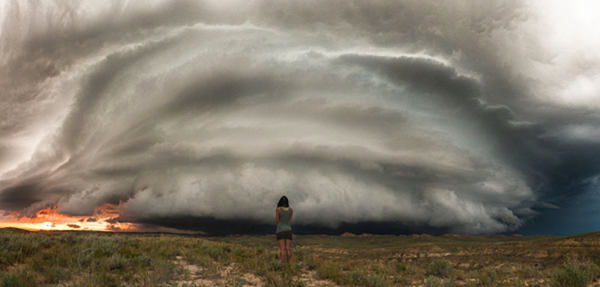Extreme Storms are Extreme Eroders
極度風暴、極度侵蝕
By Julia Rosen on April 5, 2017
影音圖文筆記下載:https://drive.google.com/open?id=0B-Bg0auB-gcobWdTUElZNUhibmM
In 2013, a rare September storm swept across the plains(平原) of Colorado. When it hit the Rockies(洛磯山脈), it dropped more than a foot of rain in places like Boulder(科羅拉多波德鎮) — as much as the city sees(見證) in an entire year. The rain unleashed(突然釋放) deadly floods and landslides that swept away roads and buildings. In fact, a new study found that a century’s worth of(足夠一世紀的) erosion and sedimentation(沉積過程) took place in a matter of(只不過才, = just, only) a few days.
2013年,罕見的九月風暴橫掃(swept across)科羅拉多平原(plains),當它抵達(hit)洛磯山脈,光是在波德這樣的小鎮就降下一英尺的雨量,相當於該鎮一年全部雨量,這場雨爆發(unleashed)致命的洪水和土石流(landslides),將道路和建築夷為平地(swept away),事實上,一項新的研究發現,本來需要一個世紀才能造成的侵蝕和沉積過程,只不過(in a matter of)幾天就完成了(took place, 發生)。
“Once the flooding started, it happened quickly, and took a lot of people unawares.”
Sara Rathburn, a geoscientist at Colorado State University in Fort Collins who experienced the storm herself. On top of (除了…還…) the damage to manmade structures(大型建築物), Rathburn knew that the floods moved huge amounts of sediment(沉積物), wood, and the organic carbon(有機碳) they contain. She saw a unique opportunity to put hard numbers(確實的數字) on what went where: At the base of one of the watersheds that flooded, a reservoir captured everything that flowed downhill.
「一旦洪水開始,就發生非常快速,讓許多人措手不及(took sb unawares)。」
柯林斯堡科羅拉多州立大學地理學家莎拉瑞斯本,她本人親身經歷這起風暴,風暴除了(on top of)人造大型建築物(structures)的破壞,瑞斯本知道洪水還攜帶走大量的沉積物(sediment)、木頭和有機碳,她看到罕見的機會(unique opportunity),可以給出哪些東西衝到哪裡的確實數據(hard numbers):在被淹沒(flooded)的分水嶺底部,一座水庫取得全部衝下山的東西。
“I was thinking about being able to track the sediment from the source to what I’m calling this anthropogenic sink — the reservoir — and really quantify it. We don’t have a lot of control on absolutely capturing everything that these large storms produce…and so the fact that the reservoir was capturing everything really seemed like a unique opportunity.”
「我本來的想法是,從起源處追蹤(track)沉積物,一路追蹤到我所謂的人為(anthropogenic)水槽,也就是水庫,然後真的給它量化,我們沒有太大能力取得全部所有洪水產生的東西,所以說,水庫所取得的每一件東西似乎是個罕見的機會。」
So Rathburn and her colleagues got a Rapid Response Research grant from the National Science Foundation to study what happened. The team compared detailed maps of the landscape(地形地貌) and the lakebed before and after the storm, then they quantified the difference. They found that half a million cubic yards of sediment washed downstream during the storm, a volume that would normally take up to 115 years to erode. About 60% of it accumulated in the reservoir, taking up 2% of its storage space.
瑞斯本和她同事從國家科學基金會取得快速反應研究計畫補助金(grant),用來研究實際發生的情況,該團隊比較風暴前後詳細的地形地貌圖和湖床,把前後差異進行數據量化,他們發現在風暴期間,有五十萬立方碼的沉積物被沖刷下來,通常需要一百一十五年的侵蝕才能有這樣的總量(volume),大約有百分之六十堆積在水庫裡,占(taking up)蓄水量百分之二。
The rest of the material was deposited partway down the river, where it will continue to be released into the reservoir for years to come, Rathburn says, causing ongoing headaches for dam managers…who are also worried about large logs clogging the openings that they use to release water. The findings are in the journal Geology.
其它的東西沿著河水沉積在半路上,這些東西會在幾年內流入水庫裡,瑞斯本說,這會讓水壩經理們頭痛不已(ongoing headaches ),他們也擔心大型圓木堵塞(clog)水庫放水口。這份研究結果發表在地理期刊。
The storm was an extreme event. But Rathburn says such episodes (事件)are becoming more and more common.
“I really do think it’s climate-change driven. And that it’s something that’s just absolutely worthy and necessary of our study and our investigation. It’s too risky to ignore, given what it means for people living in places where hazards(隱憂、危害物) occur, which is almost everywhere.”
這風暴是一個極端事件,但是瑞斯本說這樣的事件會越來越頻繁。
「我真的認為這風暴是氣候變遷所驅動的,這就是我們的研究調查的價值和必要性所在,忽視是危險的,尤其是對住在有隱憂處的居民來說,處處是危險。」




 留言列表
留言列表


